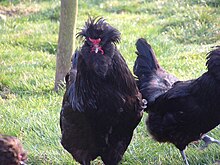Crèvecœur chicken
 From Wikipedia the free encyclopedia
From Wikipedia the free encyclopedia
 Crèvecœur cock (foreground) | |
| Conservation status | FAO (2007): endangered |
|---|---|
| Country of origin | France |
| Use | dual-purpose, meat and eggs; fancy |
| Traits | |
| Weight | |
| Egg colour | white |
| Comb type | V-shaped |
| Classification | |
| APA | continental[2] |
| ABA | all other comb clean legged |
| PCGB | rare soft feather: heavy[3] |
| Notes | |
| crested breed | |
| |
The Crèvecœur is an endangered historic breed of crested chicken from the Pays d'Auge, in the Calvados département of Normandy, in north-western France. It is named after the commune of Crèvecœur-en-Auge. It is related to the La Flèche and to other Norman breeds such as the Caumont and Caux and the extinct Pavilly; the Merlerault was formerly considered a sub-type of the Crèvecœur.
History[edit]
The Crèvecœur is among the oldest French breeds of chicken; its origins are unknown. It takes its name from the commune of Crèvecœur-en-Auge, near Lisieux in the historic region of the Pays d'Auge, in the Calvados département of Normandy. Crèvecoeur chickens won prizes at the Exposition Universelle of 1855 in Paris.[4]: 37 The breed was described in detail by Louis Bréchemin in 1894,[5][6] but the breed standard was not accepted by the Société d’Aviculture de Basse-Normandie until 1909.[5]
The Crèvecœur was reared in the United Kingdom from the mid-nineteenth century,[1]: 92 and was added to the Standard of Perfection of the American Poultry Association in 1874.[2]
The French population of the breed suffered during both the First and Second World Wars; after the latter, it was thought to have virtually disappeared. Recovery was begun in 1976 by Jean-Claude Périquet. In 1995 numbers were reported to be between 100 and 1000 individuals;[7] in 2007 the breed was classified by the FAO as "endangered".[8]: 152
Bantam versions were separately developed in the United States from about 1960, and in Germany towards 2000.[1]: 92
Characteristics[edit]
The Crèvecœur has a crest similar to that of the Houdan breed. Unlike the Houdan, it is four-toed and has a V-shaped comb like that of the La Flèche.[9]: 331
It is most commonly black,[10] and this is the only colour variant recognised in the United Kingdom and in the United States.[11]: 114 [2] Three other colours are recognised in France: blue,[12] white,[13] and cuckoo.[8]: 45 [14] The face, comb, ear-lobes and wattles are bright red, the legs and feet slate blue or black. The beak is a dark horn colour, the eyes may be red or sometimes black.[11]: 114
Use[edit]
The Crèvecœur was traditionally kept as a dual-purpose chicken, raised both for its eggs and for its meat, which is of high quality.[1]: 92 The eggs are white, and weigh about 55 g.[4]: 37 It is now raised primarily for poultry exhibition.[4]: 37
References[edit]
- ^ a b c d e f g Jean-Claude Periquet (2015). Races de poules et de coqs de France (in French). Paris: France agricole. ISBN 9782855573861.
- ^ a b c APA Recognized Breeds and Varieties: As of January 1, 2012. American Poultry Association. Archived 4 November 2017.
- ^ Breed Classification. Poultry Club of Great Britain. Archived 12 June 2018.
- ^ a b c Nathalie Semenuik, Georges Pernot (photographs) (2008). Les poules (in French). Paris: Artemis. ISBN 9782844166937.
- ^ a b Pierre-Alain Falquet (2014). Coup de coeur pour la Crèvecoeur (in French). Club Suisse des Volailles Françaises. Accessed September 2016.
- ^ Louis Bréchemin (1893). Élevage moderne des animaux de basse-cour. Poules et poulaillers, élevage naturel et artificiel, monographie de toutes les races (in French). Paris: E. Dentu. Page 72–75.
- ^ Breed data sheet: Crèvecoeur/France. Domestic Animal Diversity Information System of the Food and Agriculture Organization of the United Nations. Accessed September 2016.
- ^ a b Barbara Rischkowsky, D. Pilling (eds.) (2007). List of breeds documented in the Global Databank for Animal Genetic Resources, annex to The State of the World's Animal Genetic Resources for Food and Agriculture. Rome: Food and Agriculture Organization of the United Nations. ISBN 9789251057629. Accessed May 2014.
- ^ Victoria Roberts (2008). British poultry standards: complete specifications and judging points of all standardized breeds and varieties of poultry as compiled by the specialist breed clubs and recognised by the Poultry Club of Great Britain. Oxford: Blackwell. ISBN 9781405156424.
- ^ Breed data sheet: Crèvecoeur noire/France. Domestic Animal Diversity Information System of the Food and Agriculture Organization of the United Nations. Accessed September 2016.
- ^ a b J. Ian H. Allonby, Philippe B. Wilson (editors) (2018). British Poultry Standards: complete specifications and judging points of all standardized breeds and varieties of poultry as compiled by the specialist breed clubs and recognised by the Poultry Club of Great Britain, seventh edition. Chichester; Hoboken, New Jersey: Wiley Blackwell. ISBN 9781119509141.
- ^ Breed data sheet: Crèvecoeur bleue/France. Domestic Animal Diversity Information System of the Food and Agriculture Organization of the United Nations. Accessed September 2016.
- ^ Breed data sheet: Crèvecoeur blanche/France. Domestic Animal Diversity Information System of the Food and Agriculture Organization of the United Nations. Accessed September 2016.
- ^ Breed data sheet: Crèvecoeur coucou/France. Domestic Animal Diversity Information System of the Food and Agriculture Organization of the United Nations. Accessed September 2016.